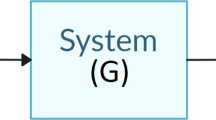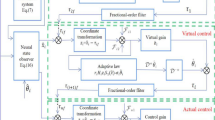Abstract
In this paper, a time-optimal control problem is considered for plants represented by chains of integrators. A suboptimal solution obtained by using the implicit Lyapunov function approach is proposed in the form of continuous finite-time state feedback regulator. An algorithm for optimal tuning the parameters of the controller is formulated as a finite-dimensional semidefinite program. A robustness-oriented comparison of the optimal and suboptimal solutions in practical implementations of the proposed controller is performed via the numerical example of double integrator.
Similar content being viewed by others
References
Feldbaum, A., Optimal Processes in Systems of Automatic Control. Avtom. Telemekh., 1953, vol. 14, no. 6, pp. 721–728.
Pontryagin, L.S., Boltyanski, V.G., Gamkrelidze, R.V., et al., The Mathematical Theory of Optimal Processes, New York: Interscience, 1964.
Bellman, R.E., Dynamic Programming, New Jersey: Princeton Univ. Press, 1957.
Lasserre, J.B., Prieur, C., and Henrion, D., Nonlinear Optimal Control: Numerical Approximations via Moments and LMI-Relaxations, Proc. 44th IEEE Conf. Decision Control, 2005, pp. 1648–1653.
Chernousko, F.L., Ananevskii, I.M., and Reshmin, S.A., Control of Nonlinear Dynamical Systems: Methods and Applications, Berlin: Springer-Verlag, 2008.
Dinuzzo, F. and Ferrara, A., Higher Order Sliding Mode Controllers with Optimal Reaching, IEEE Trans. Automat. Control, 2009, vol. 54, no. 9, pp. 2126–2136.
Boltyanski, V.G. and Poznyak, A.S., The Robust Maximum Principle: Theory and Applications, Boston: Birkhäuser, 2012.
Bernstein, D.S., Optimal Nonlinear, but Continuous, Feedback Control of Systems with Saturating Actuators, Int. J. Control, 1995, vol. 62, no. 5, pp. 1209–1216.
Glizer, V.Y. and Turetsky, V., Robust Controllability of Linear Systems, New York: Nova Science, 2012.
Bertsekas, D.P., Dynamic Programming and Suboptimal Control: A Survey from ADP to MPC, Eur. J. Control, 2005, vol. 11, pp. 310–334.
Bohl, A.H. and McAvoy, T.J., Linear Feedback vs. Time Optimal Control, Indust. Eng. Chem. Process Des. Development, 1976, vol. 15, no. 1, pp. 24–33.
Zubov, V.I., On Systems of Homogenous Differential Equations with Generalized Homogenous Righthand Sides, Izv. Vissh. Uchebn. Zaved., Mat., 1958, no. 1, pp. 80–88.
Rosier, L., Homogenous Lyapunov Function for Homogenous Coninuous Vector Field, Syst. Control Lett., 1992, vol. 19, pp. 467–473.
Bhat, S.P. and Bernstein, D.S., Geometric Homogeneity with Applications to Finite-time Stability, Math. Control Sig. Sys., 2005, vol. 17, pp. 101–127.
Bernuau, E., Efimov, D., Perruquetti, W., et al., On Homogeneity and Its Application in Sliding Mode Control, J. Franklin Inst., 2014, vol. 351, no. 4, pp. 1866–1901.
Adamy, J. and Flemming, A., Soft Variable-Structure Controls: A Survey, Automatica, 2004, vol. 40, pp. 1821–1844.
Polyakov, A., Efimov, D., and Perruquetti, W., Finite-time and Fixed-time Stabilization: Implicit Lyapunov Function Approach, Automatica, 2015, vol. 51, no. 1, pp. 332–340.
Courant, R. and John, F., Introduction to Calculus and Analysis, New York: Springer, 2000, vol. II, no. 1.
Korobov, V.I., Metod funktsii upravlyaemosti (Controllability Function Method), Moscow: Regular and Chaotic Dynamics, 2007.
Boyd, S., El Ghaoui, L., Feron, E., et al., Linear Matrix Inequalities in System and Control Theory, Philadelphia: SIAM, 1994.
Polyak, B.T., Khlebnikov, M.V., and Shcherbakov, P.S., Upravlenie lineinymi sistemami pri vneshnikh vozmushcheniyakh: tekhnika lineinykh matrichnykh neravenstv (Control of Linear Systems Subject to Exogenous Disturbances: The Linear Matrix Inequalitiy Technique), Moscow: LENAND, 2014.
Poznyak, A., Polyakov, A., and Azhmyakov, V., Attractive Ellipsoids in Robust Control, Boston: Birkhäuser, 2014.
Utkin, V.I., Guldner, J., and Shi, J., Sliding Mode Control in Electro-Mechanical Systems, Boca Raton: CRC Press, 2009.
Biagiotti, L. and Zanasi, R., Time-Optimal Regulation of a Chain of Integrators with Saturated Input and Internal Variables: An Application to Trajectory Planning, Proc. 8th IFAC Symp. Nonlin. Control Syst., 2010, pp. 1278–1283.
Wang, X., Saberi, A., Stoorvogel, A., et al., Control of a Chain of Integrators Subject to Actuator Saturation and Disturbances, Int. J. Robust Nonlin. Control, 2012, vol. 22, no. 14, pp. 1562–1570.
Control of Uncertain Systems with Bounded Inputs, Lect. Notes in Control Inform. Sci., Tarbouriech, S. and Garcia, G., Eds., New York: Springer-Verlag, 1997.
Shinar, J., Glizer, V.Y., and Turetsky, V., Capture Zone of Linear Strategies in Interception Problems with Variable Structure Dynamics, J. Franklin Inst., 2014, vol. 351, no. 4, pp. 2378–2395.
Roxin, E., On Finite Stability in Control Systems, Rendiconti del Circolo Matematico di Palermo, 1966, vol. 15, no. 3, pp. 273–283.
Bhat, S.P. and Bernstein, D.S., Finite-time Stability of Continuous Autonomous Systems, SIAM J. Control Optimiz., 2000, vol. 38, no. 3, pp. 751–766.
Orlov, Y., Finite Time Stability and Robust Control Synthesis of Uncertain Switched Systems, SIAM J. Control Optimiz., 2005, vol. 43, no. 4, pp. 1253–1271.
Polyakov, A. and Poznyak, A., Method of Lyapunov Functions for Systems with Higher-order Sliding Modes, Autom. Remote Control, 2011, vol. 72, no. 5, pp. 944–963.
Polyakov, A. and Fridman, L., Stability Notions and Lyapunov Functions for Sliding Mode Control Systems, J. Franklin Inst., 2014, vol. 351, no. 4, pp. 1831–1865.
Zubov, V.I., Methods of A.M. Lyapunov and Their Applications, Leiden: Noordhoff, 1964.
Hahn, W., Stability of Motion, New York: Springer-Verlag, 1967.
Hermes, H., Nilpotent Approximations of Control Systems and Distributions, SIAM J. Control Optimiz., 1986, vol. 24, pp. 731–736.
Levant, A., Homogeneity Approach to High-order Sliding Mode Design, Automatica, 2005, vol. 41, pp. 823–830.
Ryan, E.P., Universal Stabilization of a Class of Nonlinear Systems with Homogeneous Vector Fields, Syst. Control Lett., 1995, vol. 26, pp. 177–184.
Hong, Y., H ∞ Control, Stabilization, and Input-output Stability of Nonlinear Systems with Homogeneous Properties, Automatica, 2001, vol. 37, no. 7, pp. 819–829.
Bernuau, E., Polyakov, A., Efimov, D., et al., Verification of ISS, iISS and IOSS Properties Applying Weighted Homogeneity, Syst. Control Lett., 2013, vol. 62, no. 12, pp. 1159–1167.
Bacciotti, A. and Rosier, L., Lyapunov Functions and Stability in Control Theory, New York: Springer, 2005, 2nd ed.
Sontag, E.D., Smooth Stabilization Implies Coprime Factorization, IEEE Trans. Automat. Control, 1989, vol. 34, no. 4, pp. 435–443.
Dashkovskiy, S.N., Efimov, D.V., and Sontag, E.D., Input to State Stability and Allied System Properties Autom. Remote Control, 2011, vol. 72, no. 8, pp. 1579–1614.
Korobov, V.I., A General Approach to Synthesis Problem, Dokl. Akad. Nauk SSSR, 1979, vol. 248, pp. 1051–1063.
Tuan, H.D., Apkaryan, P., and Tuy, H., Advanced Global Optimization Algorithms for Parameterized LMIs, Proc. 38th Conf. Decision Control, Pheonix, 1999.
Author information
Authors and Affiliations
Corresponding author
Additional information
Original Russian Text © A.E. Polyakov, 2015, published in Avtomatika i Telemekhanika, 2015, No. 5, pp. 145–164.
Rights and permissions
About this article
Cite this article
Polyakov, A.E. Time-suboptimal feedback design via linear matrix inequalities. Autom Remote Control 76, 847–862 (2015). https://doi.org/10.1134/S0005117915050100
Received:
Published:
Issue Date:
DOI: https://doi.org/10.1134/S0005117915050100




